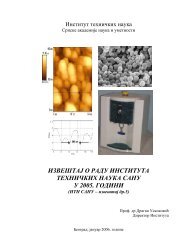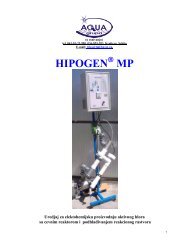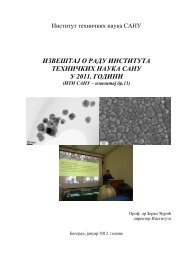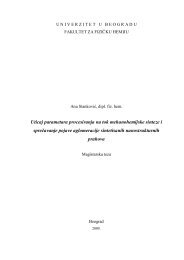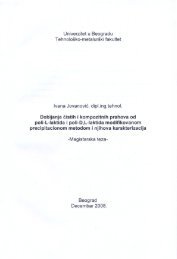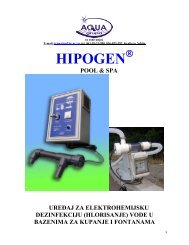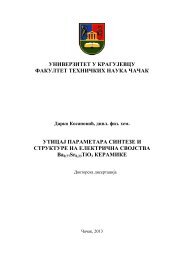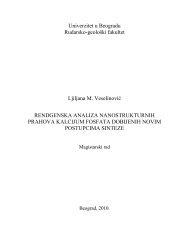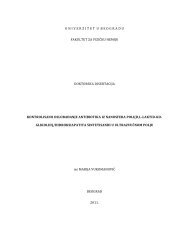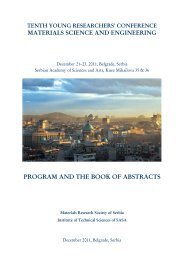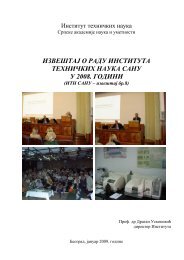Nanospheres for the Sustained Release of Folic Acid
Nanospheres for the Sustained Release of Folic Acid
Nanospheres for the Sustained Release of Folic Acid
Create successful ePaper yourself
Turn your PDF publications into a flip-book with our unique Google optimized e-Paper software.
Copyright © 2008 American Scientific Publishers<br />
All rights reserved<br />
Printed in <strong>the</strong> United States <strong>of</strong> America<br />
Journal <strong>of</strong><br />
Biomedical Nanotechnology<br />
Vol.4, 1–10, 2008<br />
Poly(DL-lactide-co-glycolide) <strong>Nanospheres</strong> <strong>for</strong> <strong>the</strong><br />
<strong>Sustained</strong> <strong>Release</strong> <strong>of</strong> <strong>Folic</strong> <strong>Acid</strong><br />
Magdalena Stevanović 1 ∗ , Aleksandra Radulović 2 , Branka Jordović 3 , and Dragan Uskoković 1<br />
1 Institute <strong>of</strong> Technical Sciences <strong>of</strong> <strong>the</strong> Serbian Academy <strong>of</strong> Sciences and Arts, Belgrade 11000, Serbia<br />
2 Institute <strong>of</strong> General and Physical Chemistry, Belgrade 11000, Serbia<br />
3 Faculty <strong>of</strong> Technical Sciences, Čačak 32000, Serbia<br />
Biodegradable polymers have become <strong>the</strong> materials <strong>of</strong> choice <strong>for</strong> a variety <strong>of</strong> biomedical applications.<br />
In particular, poly(DL-lactide-co-glycolide) nanoparticles have been studied as a material<br />
<strong>for</strong> drug delivery with <strong>the</strong> controlled release. In this paper we are describing a simple<br />
method <strong>for</strong> obtaining <strong>the</strong> system <strong>for</strong> targeted and controlled delivery <strong>of</strong> folic acid in <strong>the</strong> body.<br />
<strong>Folic</strong> acid was encapsulated into <strong>the</strong> polymer matrixby means <strong>of</strong> homogenization <strong>of</strong> aqueous<br />
and organic phases. Concentration <strong>of</strong> folic acid in water was varied in order to obtain<br />
nanoparticles with different ratios <strong>of</strong> poly(DL-lactide-co-glycolide) and folic acid. The particles were<br />
obtained by physicochemical solvent/non-solvent method with polyvinyl pyrrolidone as a surfactant.<br />
The obtained particles are non-agglomerated, uni<strong>for</strong>m and with particles size in <strong>the</strong> nanometer<br />
range. The samples were characterized using Infrared Spectroscopy (IR), Ultraviolet Spectroscopy<br />
(UV), Zeta potential measurements, Scanning Electron Microscopy (SEM) and Stereological<br />
analysis.<br />
Keywords: Poly(DL-lactide-co-glycolide), <strong>Folic</strong> <strong>Acid</strong>, Nanoparticles, IR, SEM, UV-Vis, Zeta<br />
Potential Measurements, Stereological Analysis, Drug Delivery.<br />
1. INTRODUCTION<br />
Poly(DL-lactide-co-glycolide) (PLGA or DLPLG) is a<br />
very popular copolymer used <strong>for</strong> various medical, pharmaceutical,<br />
industrial and o<strong>the</strong>r purposes.The most attractive<br />
application <strong>of</strong> this copolymer is, however, in medicine and<br />
pharmacy because it is a very suitable <strong>for</strong> <strong>the</strong> controlled<br />
delivery <strong>of</strong> medicaments in <strong>the</strong> body. 1 Poly(DL-lactideco-glycolide)-based<br />
micro- and nanoparticles <strong>of</strong>fer various<br />
advantages compared to o<strong>the</strong>r controlled drug delivery systems,<br />
including: <strong>the</strong> possibility to accurately control <strong>the</strong><br />
resulting drug release kinetics over periods <strong>of</strong> days to<br />
months, complete biodegradability, good biocompatibility,<br />
easy administration into <strong>the</strong> body, etc. 2–4 Morphological<br />
characteristics <strong>of</strong> <strong>the</strong> particles, like size, size distribution<br />
and shape, are extremely important <strong>for</strong> <strong>the</strong> controlled<br />
drug delivery, and are particularly influencing <strong>the</strong> adhesion<br />
and interaction with cells (intracellular uptake). 5–9 Polymer<br />
degradation, dynamics <strong>of</strong> <strong>the</strong> release (rate and concentration)<br />
<strong>of</strong> drugs from <strong>the</strong> polymer matrices depend on <strong>the</strong><br />
morphology <strong>of</strong> <strong>the</strong> particles (size, shape, uni<strong>for</strong>mity, pore<br />
5 10–13<br />
size structure, etc.).<br />
∗<br />
Author to whom correspondence should be addressed.<br />
<strong>Folic</strong> acid (pteroyl-L-glutamic acid, vitamin B 9 ) is a<br />
water-soluble vitamin that is essential in <strong>the</strong> human diet.<br />
It is necessary <strong>for</strong> <strong>the</strong> production and maintenance <strong>of</strong><br />
new cells. 14 This is especially important during <strong>the</strong> periods<br />
<strong>of</strong> rapid cell division and growth such as pregnancy<br />
and infancy when it is <strong>of</strong>ten necessary to take specific<br />
dosages <strong>of</strong> folic acid on daily basis. 15 <strong>Folic</strong> acid is needed<br />
to replicate DNA.Thus folic acid deficiency hinders DNA<br />
syn<strong>the</strong>sis and cell division.Because RNA and protein syn<strong>the</strong>sis<br />
are not hindered, large red blood cells called megaloblasts<br />
are produced, resulting in megaloblastic anemia. 15<br />
Both adults and children need folic acid to make normal<br />
red blood cells and prevent anemia.<strong>Folic</strong> acid also helps<br />
prevent changes to DNA that may lead to cancer. 16 Also,<br />
one <strong>of</strong> <strong>the</strong> most extensively studied small molecule targeting<br />
moieties <strong>for</strong> drug delivery is folic acid (folate).The<br />
high-affinity vitamin is a commonly used ligand <strong>for</strong> cancer<br />
targeting because folate receptors are frequently overexpressed<br />
in a range <strong>of</strong> tumor cells. 17–19<br />
In this work we followed <strong>the</strong> concept which we have<br />
already applied successfully in <strong>the</strong> encapsulation <strong>of</strong> ascorbic<br />
acid in PLGA nanoparticles. 20 Ascorbic acid (vitamin<br />
C) is also a water-soluble vitamin.The method we<br />
employed is also based on <strong>the</strong> fact that PLGA and folic<br />
RESEARCH ARTICLE<br />
J. Biomed. Nanotechnol. 2008, Vol. 4, No. 3 1550-7033/2008/4/001/010 doi:10.1166/jbn.2008.021 1
Poly(DL-lactide-co-glycolide) <strong>Nanospheres</strong> <strong>for</strong> <strong>the</strong> <strong>Sustained</strong> <strong>Release</strong> <strong>of</strong> <strong>Folic</strong> <strong>Acid</strong><br />
Stevanovi et al.<br />
acid (or ascorbic acid) are not miscible because PLGA is<br />
a polymer insoluble in water.With <strong>the</strong> encapsulation <strong>of</strong><br />
folic acid into a PLGA polymer matrix, it may be possible<br />
to achieve its higher efficiency in <strong>the</strong> body.<br />
2. MATERIALS AND METHODS<br />
2.1. Materials<br />
Poly(DL-lactide-co-glycolide) (PLGA) was purchased<br />
from Durect, Lactel, and had a lactide-to-glycolide ratio<br />
<strong>of</strong> 50:50.Molecular weight <strong>of</strong> <strong>the</strong> polymer was 40000–<br />
50000 g/mol.The time <strong>for</strong> its complete resorption in <strong>the</strong><br />
body is 4 to 8 weeks.Molecular weight <strong>of</strong> folic acid<br />
is 441.14 g/mol (Microvit TM , Adisseo).Polyvinyl pyrrolidone<br />
(povidone, PVP) was obtained from Merck Chemicals<br />
Ltd (k-25, Merck, Germany).All o<strong>the</strong>r chemicals and<br />
solvents were <strong>of</strong> reagent grade.<br />
2.2. PLGA/<strong>Folic</strong> <strong>Acid</strong> Nanoparticles Formulation<br />
water until a slightly alkaline environment was reached,<br />
all in order to increase <strong>the</strong> solubility <strong>of</strong> folic acid.This<br />
was followed by precipitation using 22 ml <strong>of</strong> methanol<br />
(step 3).Thus obtained solution was very slowly poured<br />
(instilled <strong>for</strong> 15 min) into 40 ml <strong>of</strong> aqueous PVP solution<br />
(0.05% w/w) while continuously stirring at 1200 rpm<br />
(step 4).Surface charge <strong>of</strong> <strong>the</strong> particles in <strong>the</strong> dispersion<br />
was determined by zeta potential measurements.After that,<br />
<strong>the</strong> solution was centrifuged at 4000 rpm <strong>for</strong> 120 min,<br />
decanted and dried (step 5, 6 and 7).The supernatant solution<br />
was stored <strong>for</strong> <strong>the</strong> analysis <strong>of</strong> folic acid content using<br />
spectrophotometry.<br />
2.3. Percentage Yield<br />
Particles, dried at room temperature, were weighed, and<br />
<strong>the</strong> yield was calculated in percentages using equation:<br />
Percentage yield = weight <strong>of</strong> particles/<br />
weight <strong>of</strong> polymer + weight <strong>of</strong> folic acid × 100<br />
RESEARCH ARTICLE<br />
Nanoparticles composed <strong>of</strong> PLGA and folic acid were<br />
syn<strong>the</strong>sized following a variant <strong>of</strong> <strong>the</strong> method which has<br />
already been applied in <strong>the</strong> encapsulation <strong>of</strong> ascorbic acid<br />
in PLGA nanoparticles. 20 At room temperature, commercial<br />
granules <strong>of</strong> poly(DL-lactide-co-glycolide) (0.25 g)<br />
were solubilized in 20 ml <strong>of</strong> acetone during two hours<br />
(step 1).Afterwards, <strong>the</strong> aqueous solution <strong>of</strong> folic acid<br />
(5 ml) was added in PLGA solution in acetone while<br />
continuously being homogenized at 200 rpm during<br />
30 minutes (step 2).Concentration <strong>of</strong> folic acid in water<br />
was varied in order to obtain nanoparticles with different<br />
ratio <strong>of</strong> PLGA and folic acid (PLGA/folic acid<br />
95/5%wt, PLGA/folic acid 90/10%wt, PLGA/folic acid<br />
85/15%wt and PLGA/folic acid 80/20%wt).Accordingly,<br />
<strong>the</strong> weights <strong>of</strong> folic acid in 5 ml <strong>of</strong> water were 13.2 mg,<br />
27.8 mg, 44.1 mg, and 62.5 mg. During <strong>the</strong> solvation<br />
<strong>of</strong> folic acid, sodium hydrogen carbonate was added to<br />
2.4. Loading Amount and Loading Efficiency<br />
<strong>Folic</strong> acid absorbs light at <strong>the</strong> wavelength <strong>of</strong> 259 and<br />
362 nm.Based on measuring absorbance <strong>of</strong> <strong>the</strong> solution<br />
with a known concentration <strong>of</strong> folic acid (Fig.2(a)) at<br />
362 nm, a calibration curve was prepared (Fig.2(b)).<br />
The liner relationship between light absorbance at<br />
362 nm and folic acid concentration is shown according<br />
to <strong>the</strong> Beer-Lambert Law: A= cl (where A is absorbance<br />
at sample concentration c (in this case concentration <strong>of</strong><br />
<strong>the</strong> folic acid (mg/ml)), l is <strong>the</strong> path length <strong>of</strong> quartz cell<br />
and is <strong>the</strong> absortivity).By applying this standardized<br />
relationship, supernatant obtained during <strong>the</strong> syn<strong>the</strong>sis was<br />
analyzed to determine <strong>the</strong> concentration and amount <strong>of</strong><br />
non-encapsulated folic acid.Knowing <strong>the</strong> initial amount <strong>of</strong><br />
folic acid used in PLGA/folic acid nanoparticle syn<strong>the</strong>sis,<br />
<strong>the</strong> percentage <strong>of</strong> folic acid loaded into <strong>the</strong> nanoparticles<br />
Dissolving<br />
+water<br />
solution <strong>of</strong><br />
folic acid<br />
Precipitation<br />
stabilization<br />
with zeta<br />
potential<br />
Centrifugation<br />
Decanting<br />
Drying<br />
Step 1 Step 2 Step 3 Step 4<br />
Step<br />
5,6,7<br />
Fig. 1.<br />
Scheme <strong>of</strong> <strong>the</strong> syn<strong>the</strong>sis <strong>of</strong> <strong>the</strong> PLGA/folic acid nanoparticles.<br />
2 J. Biomed. Nanotechnol. 4, 1–10, 2008
Stevanovi et al.<br />
(a)<br />
Poly(DL-lactide-co-glycolide) <strong>Nanospheres</strong> <strong>for</strong> <strong>the</strong> <strong>Sustained</strong> <strong>Release</strong> <strong>of</strong> <strong>Folic</strong> <strong>Acid</strong><br />
determination (5 nm–10 m), Malvern Instruments,<br />
Malvern, UK) using <strong>the</strong> principle <strong>of</strong> electrophoretic mobility<br />
under an electric field.Zeta potential is <strong>the</strong> function <strong>of</strong><br />
dispersion/suspension pH which determines particle stability<br />
in dispersion.<br />
2.7. Morphology Studies<br />
The morphology <strong>of</strong> <strong>the</strong> obtained particles <strong>of</strong> PLGA without<br />
and with folic acid was examined using a JEOL JSM-<br />
646OLV scanning electron microscope (SEM).The powder<br />
samples <strong>for</strong> SEM analysis were sputtered with gold using<br />
<strong>the</strong> physical vapor deposition (PVD) process.The samples<br />
were sputtered (SCD 005 sputter coater), using 30 mA current<br />
from <strong>the</strong> distance <strong>of</strong> 50 mm during 180 s.<br />
(b)<br />
2.8. Stereological Analysis<br />
The particle size and morphology were examined using<br />
<strong>the</strong> area analysis method 21 22 (Leica Q500MC with Leica<br />
QWin s<strong>of</strong>tware).A few hundred particles from a representative<br />
SEM image were measured, and <strong>the</strong> following<br />
parameters were determined: area section Aa, perimeter Lp,<br />
maximal diameter <strong>of</strong> <strong>the</strong> particle Dmax, feret x and feret y.<br />
2.9. In Vitro Drug <strong>Release</strong><br />
Fig. 2. (a) UV spectra <strong>of</strong> <strong>the</strong> solution with a known concentration <strong>of</strong><br />
folic acid and (b) graph <strong>of</strong> <strong>the</strong> linear relationship between folic acid<br />
concentration (mg/mL) and absorbance at 362 nm as obtained from <strong>the</strong><br />
samples with known folic acid concentration.<br />
was obtained (loading efficiency).Loading amount was<br />
calculated by means <strong>of</strong> equation:<br />
Loading amount = Loading efficiency%/100<br />
×Total amount <strong>of</strong> folic acid added<br />
The concentration <strong>of</strong> folic acid in <strong>the</strong> phosphate buffered<br />
saline (PBS, one tablet dissolved in 200 mL <strong>of</strong> deionized<br />
water yields 0.137 M sodium chloride, 0.01 M phosphate<br />
buffer and 0.0027 M potassium chloride, pH is 7.4 at 25 C,<br />
Sigma-Aldrich) as a release medium was determined with<br />
UV spectroscopy.The drug concentration in <strong>the</strong> medium<br />
was calculated using a calibration curve <strong>of</strong> <strong>the</strong> drug in <strong>the</strong><br />
corresponding release medium at various concentrations.<br />
The in vitro degradation <strong>of</strong> PLGA nanoparticles loaded<br />
with folic acid was studied by dispersing nanoparticles<br />
in PBS containing 110 l sodium azide (Sigma-Aldrich<br />
Fluka (Biochemica), 0.1 M solution NaN 3 ).The nanoparticle<br />
dispersions in closed ultacentrifugation tubes were kept<br />
at 37 C ± 1 C (Vaciotem P-Selecta), and stored in <strong>the</strong><br />
absence <strong>of</strong> light.At different time points (0–30 days), <strong>the</strong><br />
supernatant was taken and analyzed.<br />
RESEARCH ARTICLE<br />
2.5. The Quality Analysis <strong>of</strong> <strong>the</strong> Samples<br />
The quality analysis <strong>of</strong> <strong>the</strong> samples was per<strong>for</strong>med using IR<br />
spectroscopy.IR spectra were recorded in <strong>the</strong> range <strong>of</strong> 400–<br />
4000 cm −1 at a MIDAC M 2000 Series Research Laboratory<br />
FTIR Spectrometer, at 4 cm −1 resolution.Powdered samples<br />
were dispersed in KBr and compressed into pellets.<br />
2.6. Zeta Potential Measurements<br />
Zeta potential was measured by Zetasizer (Nano ZS,<br />
Model ZEN3600, particles size range <strong>for</strong> zeta potential<br />
2.10. Ultraviolet Spectroscopy (UV)<br />
The UV measurements were per<strong>for</strong>med on GBC, Cintra<br />
101 UV-Vis Spectrophotometer in <strong>the</strong> frequency interval<br />
<strong>of</strong> 200–400 nm.<br />
3. RESULTS AND DISCUSSION<br />
3.1. The Quality Analysis <strong>of</strong> <strong>the</strong> Samples<br />
In order to investigate <strong>the</strong> structural characteristics <strong>of</strong><br />
<strong>the</strong> PLGA particles with encapsulated folic acid, i.e., to<br />
J. Biomed. Nanotechnol. 4, 1–10, 2008 3
Poly(DL-lactide-co-glycolide) <strong>Nanospheres</strong> <strong>for</strong> <strong>the</strong> <strong>Sustained</strong> <strong>Release</strong> <strong>of</strong> <strong>Folic</strong> <strong>Acid</strong><br />
Stevanovi et al.<br />
(a)<br />
Table I.<br />
Percentage <strong>of</strong> yield.<br />
PLGA/folic acid % Yield %<br />
95/5 53.0<br />
90/10 51.9<br />
85/15 51.0<br />
80/20 52.3<br />
(b)<br />
confirm <strong>the</strong> qualitative composition <strong>of</strong> <strong>the</strong> samples, IR<br />
spectroscopy was used (Figs.3(a–c)).The IR spectra <strong>of</strong><br />
poly(DL-lactide-co-glycolide)/folic acid 95/5% nanoparticles<br />
are presented in Figure 3(c).Besides <strong>the</strong> characteristic<br />
groups <strong>for</strong> copolymer PLGA, 20 <strong>the</strong> spectra show<br />
all <strong>the</strong> characteristic groups <strong>for</strong> folic acid. 23 The band at<br />
3545 cm −1 belongs to <strong>the</strong> hydroxyl (O-H) stretching, while<br />
<strong>the</strong> bands at 3419 and 3328 cm −1 are N-H stretching vibration<br />
bands.<br />
The bands at 2942, 2925 and 2851 cm −1 correspond to<br />
–C-H stretching vibrations, C O bond stretching vibration<br />
<strong>of</strong> carboxyl group appears at 1695 cm −1 , while <strong>the</strong><br />
band at 1644 cm −1 belongs to C O bond stretching<br />
vibration <strong>of</strong> –CONH 2 group.The band at 1602 cm −1<br />
relates to <strong>the</strong> bending mode <strong>of</strong> N-H vibration.The band at<br />
1482 cm −1 was attributed to <strong>the</strong> characteristic absorption<br />
band <strong>of</strong> phenyl ring, whereas <strong>the</strong> one at 1411 cm −1 corresponds<br />
to O-H de<strong>for</strong>mation band <strong>of</strong> <strong>the</strong> phenyl skeleton.<br />
3.2. Percentage <strong>of</strong> Yield in Preparation<br />
RESEARCH ARTICLE<br />
(c)<br />
The results <strong>of</strong> <strong>the</strong> determination <strong>of</strong> <strong>the</strong> particle yield <strong>for</strong><br />
various PLGA/folic acid ratios were similar <strong>for</strong> each <strong>of</strong><br />
<strong>the</strong> samples and in all cases greater than 50%, as shown<br />
in Table I.<br />
3.3. Zeta Potential Measurements<br />
The results <strong>of</strong> <strong>the</strong> determination <strong>of</strong> zeta potential <strong>for</strong> PLGA<br />
particles without and with different concentration <strong>of</strong> folic<br />
acid are shown in Table II.Zeta potential was reported as<br />
<strong>the</strong> average and standard deviation <strong>of</strong> measurements, with<br />
five readings taken per sample.<br />
From <strong>the</strong> Table II we can see that all systems independently<br />
from <strong>the</strong> ratio <strong>of</strong> PLGA and folic acid posses <strong>the</strong><br />
same zeta potential.<br />
PVP was used as a stabilizer which creates negatively<br />
charged PLGA particles, that is, induces a specific zeta<br />
potential. 24 The potential at <strong>the</strong> slipping plane is called<br />
<strong>the</strong> zeta potential.Zeta potential is an important property<br />
<strong>of</strong> <strong>the</strong> particle in a dispersion as it has exert a significant<br />
Fig. 3. IR spectra <strong>of</strong> (a) PLGA, (b) folic acid and (c) PLGA/folic acid<br />
95/5% nanoparticles.<br />
Table II. Zeta potential <strong>of</strong> PLGA dispersion without and with different<br />
concentration <strong>of</strong> folic acid.<br />
PLGA/folic acid % pH Zeta potential (mV)<br />
100/0 4.30 −9.6 ± 0.3<br />
95/05 4.34 −9.3 ± 0.3<br />
90/10 4.37 −9.0 ± 0.4<br />
4 J. Biomed. Nanotechnol. 4, 1–10, 2008
Stevanovi et al.<br />
Poly(DL-lactide-co-glycolide) <strong>Nanospheres</strong> <strong>for</strong> <strong>the</strong> <strong>Sustained</strong> <strong>Release</strong> <strong>of</strong> <strong>Folic</strong> <strong>Acid</strong><br />
Table III.<br />
Loading efficiency and loading amount <strong>of</strong> PLGA/folic acid particles.<br />
PLGA/folic acid % Supernatant absorbance (362 nm) Amount <strong>of</strong> folic acid in supernatant (mg) Loading efficiency (%) loading amount (mg)<br />
95/5 0.1195 2.785 78.9 10.415<br />
90/10 0.2641 6.394 77.0 21.406<br />
85/15 0.4352 10.937 75.2 33.163<br />
80/20 0.5705 14.375 77.0 48.125<br />
o<strong>the</strong>r.The concentration <strong>of</strong> PVP stabilizer is optimized<br />
in order to obtain <strong>the</strong> smallest particle dimensions <strong>for</strong><br />
this method as well as to reduce <strong>the</strong> agglomeration to a<br />
24 29<br />
minimum. A known problem addressed in <strong>the</strong> literature,<br />
which can occur with <strong>the</strong> particle stabilizer is its<br />
difficult removal from <strong>the</strong> system. 27 30 The remains <strong>of</strong> <strong>the</strong><br />
stabilizer are <strong>of</strong>ten modifying surface characteristics <strong>of</strong><br />
<strong>the</strong> particles, thus affecting <strong>the</strong> degradation rate, distribution<br />
throughout <strong>the</strong> body, release <strong>of</strong> <strong>the</strong> medicament and<br />
biocompatibility. 28 30 There<strong>for</strong>e, <strong>the</strong> percentage <strong>of</strong> <strong>the</strong> used<br />
PVP is only 0.05%.<br />
3.4. Loading Amount and Loading Efficiency<br />
Fig. 4.<br />
UV spectra <strong>of</strong> folic acid from <strong>the</strong> supernatant.<br />
influence on <strong>the</strong>ir stability.Theoretically, zeta potential<br />
stabilizes suspensions whe<strong>the</strong>r its value is positive or<br />
negative. 25–28 PVP reduces <strong>the</strong> agglomeration because <strong>the</strong><br />
particles <strong>of</strong> <strong>the</strong> same charge are not attracted to each<br />
The supernatant obtained from PLGA/folic acid nanoparticle<br />
syn<strong>the</strong>sis was analysed by UV spectrophotometry to<br />
determine <strong>the</strong> amount <strong>of</strong> folic acid encapsulated within<br />
<strong>the</strong> nanoparticles.The results are shown in Table III.The<br />
amount <strong>of</strong> folic acid in <strong>the</strong> supernatant has been calculated<br />
from <strong>the</strong> product <strong>of</strong> <strong>the</strong> supernatant’s absorbance at 362 nm<br />
(a)<br />
(b)<br />
RESEARCH ARTICLE<br />
(c)<br />
(d)<br />
Fig. 5. SEM images <strong>of</strong> particles with different ratio <strong>of</strong> PLGA and folic acid (a) PLGA/folic acid 95/5%, (b) PLGA/folic acid 90/10%, (c) PLGA/folic<br />
acid 85/15%, (d) PLGA/folic acid 80/20%.<br />
J. Biomed. Nanotechnol. 4, 1–10, 2008 5
Poly(DL-lactide-co-glycolide) <strong>Nanospheres</strong> <strong>for</strong> <strong>the</strong> <strong>Sustained</strong> <strong>Release</strong> <strong>of</strong> <strong>Folic</strong> <strong>Acid</strong><br />
Stevanovi et al.<br />
(Fig.4) and its measured volume (87 ml).Assuming that all<br />
<strong>of</strong> <strong>the</strong> folic acid concentration not found in <strong>the</strong> supernatant<br />
was encapsulated by PLGA nanospheres, <strong>the</strong> loading efficiency<br />
was determined to be greater than 75% in all ratios<br />
<strong>of</strong> PLGA/folic acid nanoparticles.<br />
3.5. Morphology Studies<br />
The scanning electron microscopic images <strong>of</strong> folic acidloaded<br />
nanoparticles revealed <strong>the</strong>ir regular spherical<br />
shapes in <strong>the</strong> case <strong>of</strong> PLGA/folic acid 95/5% (Fig.5(a)).<br />
Generally, <strong>the</strong>ir surface morphology was smooth without<br />
any noticeable pinholes or cracks within <strong>the</strong> conventional<br />
SEM resolution.The size distribution <strong>of</strong> all nanoparticles<br />
was unimodal with sizes in <strong>the</strong> total range <strong>of</strong> 140–240 nm<br />
as confirmed by <strong>the</strong> stereological analysis.The particles<br />
<strong>of</strong> <strong>the</strong> sample PLGA/folic acid 90/10% (Fig.5 (b)) also<br />
have spherical shapes, but <strong>the</strong>ir sizes are increased.In case<br />
<strong>of</strong> <strong>the</strong> third sample, PLGA/folic acid 85/15% (Fig.5(c)),<br />
<strong>the</strong> uni<strong>for</strong>mity is perturbed, and particles have both<br />
spherical and irregular shapes and are as well significantly<br />
agglomerated.For <strong>the</strong> fourth sample, PLGA/folic<br />
acid 80/20% (Fig.5(d)), <strong>the</strong> particles were very much<br />
agglomerated, so that <strong>the</strong> stereological analyses could not<br />
per<strong>for</strong>med.<br />
3.6. Stereological Analysis<br />
Based on <strong>the</strong> obtained results <strong>of</strong> <strong>the</strong> stereological analysis<br />
<strong>of</strong> PLGA/folic acid 95/5% nanoparticles, it is obvious that<br />
<strong>the</strong>y are uni<strong>for</strong>m: <strong>the</strong>ir average mean size varies from 140<br />
to 240 nm depending on <strong>the</strong> stereological parameter taken<br />
in consideration (Dmax, feret X or feret Y) (Table III).<br />
Feret X (<strong>the</strong> projection <strong>of</strong> <strong>the</strong> particle on x axis) values<br />
range from 70 to 300 nm with <strong>the</strong> mean size at 140 nm<br />
(Fig.6(a)).Feret Y (<strong>the</strong> projection <strong>of</strong> <strong>the</strong> particle on y axis)<br />
values range from 90 to 360 nm with <strong>the</strong> mean size at<br />
200 nm (Fig.6(a’)).For 90/10 PLGA/folic acid particles,<br />
0.00 0.03 0.06 0.09 0.12 0.15 0.18 0.21 0.24 0.27 0.30<br />
100<br />
0.00 0.04 0.08 0.12 0.16 0.20 0.24 0.28 0.32 0.36 0.40<br />
100<br />
0.00 0.09 0.18 0.27 0.36 0.45 0.54 0.63 0.72 0.81 0.90<br />
100<br />
80<br />
80<br />
80<br />
RESEARCH ARTICLE<br />
Rel.Freq., %<br />
Cum.Freq., %<br />
(a)<br />
Rel.Freq., % Cum.Freq., %<br />
60<br />
40<br />
20<br />
0<br />
20<br />
15<br />
10<br />
5<br />
0<br />
0.00 0.03 0.06 0.09 0.12 0.15 0.18 0.21 0.24 0.27 0.30<br />
Feret X, µm (b)<br />
Feret X, µm<br />
0.00 0.04 0.08 0.12 0.16 0.20 0.24 0.28 0.32 0.36 0.4<br />
100<br />
80<br />
60<br />
40<br />
20<br />
0<br />
15<br />
10<br />
5<br />
Rel.Freq., % Cum.Freq., %<br />
Rel.Freq., % Cum.Freq., %<br />
60<br />
40<br />
20<br />
0<br />
15<br />
10<br />
5<br />
0<br />
0.00 0.04 0.08 0.12 0.16 0.20 0.24 0.28 0.32 0.36 0.40<br />
0.00 0.05 0.10 0.15 0.20 0.25 0.30 0.35 0.40 0.45 0.50<br />
100<br />
80<br />
60<br />
40<br />
20<br />
20 0<br />
15<br />
10<br />
5<br />
Rel.Freq., % Cum.Freq., %<br />
(c)<br />
Rel.Freq., % Cum.Freq., %<br />
60<br />
40<br />
20<br />
0<br />
15<br />
10<br />
5<br />
0<br />
0.00 0.09 0.18 0.27 0.36 0.45 0.54 0.63 0.72 0.81 0.90<br />
Feret X, µm<br />
0.00 0.09 0.18 0.27 0.36 0.45 0.54 0.63 0.72 0.81 0.90<br />
100<br />
80<br />
60<br />
40<br />
20<br />
0<br />
15<br />
10<br />
5<br />
(a′)<br />
0<br />
0.00 0.04 0.08 0.12 0.16 0.20 0.24 0.28 0.32 0.36 0.4<br />
0<br />
0.00 0.05 0.10 0.15 0.20 0.25 0.30 0.35 0.40 0.45 0.50<br />
Feret Y, µm (b′)<br />
Feret Y, µm<br />
(c′)<br />
0<br />
0.00 0.09 0.18 0.27 0.36 0.45 0.54 0.63 0.72 0.81 0.90<br />
Feret Y, µm<br />
Fig. 6. Results <strong>of</strong> <strong>the</strong> stereological examining PLGA/folic acid particles based on feret X and feret Y in <strong>the</strong> case <strong>of</strong> nanoparticles aa’) PLGA/folic<br />
acid 95/5%, bb’) PLGA/folic acid 90/10% and cc’) PLGA/folic acid 85/15%.<br />
6 J. Biomed. Nanotechnol. 4, 1–10, 2008
Stevanovi et al.<br />
Poly(DL-lactide-co-glycolide) <strong>Nanospheres</strong> <strong>for</strong> <strong>the</strong> <strong>Sustained</strong> <strong>Release</strong> <strong>of</strong> <strong>Folic</strong> <strong>Acid</strong><br />
(a)<br />
1.60<br />
(b)<br />
2.50<br />
1.44<br />
2.25<br />
1.28<br />
2.00<br />
1.12<br />
1.75<br />
0.96<br />
1.50<br />
L P , µm<br />
0.80<br />
L P , µm<br />
1.25<br />
0.64<br />
1.00<br />
0.48<br />
0.75<br />
0.32<br />
0.50<br />
0.16<br />
0.25<br />
0.00<br />
0.00<br />
0.000 0.015 0.030 0.045 0.060 0.075 0.090 0.105 0.120 0.135 0.150<br />
0.00 0.03 0.06 0.09 0.12 0.15 0.18 0.21 0.24 0.27 0.30<br />
A A , µm 2 A A , µm 2<br />
A A , µm 2<br />
(c)<br />
4.0<br />
3.6<br />
3.2<br />
2.8<br />
L P , µm<br />
2.4<br />
2.0<br />
1.6<br />
1.2<br />
0.8<br />
0.4<br />
0.0<br />
0.0 0.1 0.2 0.3 0.4 0.5 0.6 0.7 0.8 0.9 1.0 1.1 1.2 1.3<br />
RESEARCH ARTICLE<br />
Fig. 7. Results <strong>of</strong> <strong>the</strong> stereological examining PLGA/folic acid particles based on <strong>the</strong>ir relation between area section A A and perimeter L p <strong>for</strong> aa’)<br />
PLGA/folic acid 95/5% nanoparticles, bb’) PLGA/folic acid 90/10% and cc’) PLGA/folic acid 85/15%.<br />
<strong>the</strong> mean value <strong>for</strong> feret X is 210 nm, while <strong>the</strong> mean value<br />
<strong>for</strong> feret Y is 270 nm (Fig.6(bb’)).For 85/15 PLGA/folic<br />
acid particles <strong>the</strong> mean value <strong>for</strong> feret X is 370 nm, while<br />
<strong>the</strong> mean value <strong>for</strong> feret Y is 400 nm (Fig.6(cc’)).Figure 7<br />
presents comparative results <strong>for</strong> PLGA particles with different<br />
contents <strong>of</strong> folic acid based on <strong>the</strong>ir relation between<br />
<strong>the</strong> area section A A and perimeter Lp.<br />
From <strong>the</strong> comparative results <strong>of</strong> <strong>the</strong> stereological analysis<br />
based on <strong>the</strong> maximal diameter <strong>of</strong> <strong>the</strong> particle Dmax<br />
(Fig.8, Table IV), we can see that PLGA particles without<br />
folic acid have <strong>the</strong> lowest mean value <strong>of</strong> Dmax.For PLGA<br />
particles with folic acid, it can be noted that <strong>the</strong> particles<br />
with lower content <strong>of</strong> folic acid have lower mean value <strong>of</strong><br />
Dmax.<br />
In our previous research, we encapsulated ascorbic acid<br />
into PLGA in PLGA/ascorbic acid ratios <strong>of</strong> 85/15%wt,<br />
70/30%wt, and 50/50%wt. 20 31 In <strong>the</strong> current research we<br />
are encapsulating folic acid in lesser ratios because <strong>the</strong><br />
molecular weight <strong>of</strong> folic acid (441.1396 g/mol) is lesser<br />
than <strong>the</strong> one <strong>of</strong> ascorbic acid (176.13 g/mol).<br />
3.7. In Vitro Drug <strong>Release</strong><br />
The rate <strong>of</strong> degradation <strong>of</strong> <strong>the</strong> PLGA nanospheres without<br />
and with <strong>the</strong> encapsulated folic acid as well as tracking<br />
J. Biomed. Nanotechnol. 4, 1–10, 2008 7
Poly(DL-lactide-co-glycolide) <strong>Nanospheres</strong> <strong>for</strong> <strong>the</strong> <strong>Sustained</strong> <strong>Release</strong> <strong>of</strong> <strong>Folic</strong> <strong>Acid</strong><br />
Stevanovi et al.<br />
RESEARCH ARTICLE<br />
Fig. 8. Comparative results <strong>of</strong> <strong>the</strong> stereological study <strong>of</strong> (a) PLGA<br />
nanospheres and nanoparticles with different ratio <strong>of</strong> PLGA and<br />
folic acid, (b) PLGA/folic acid 95/5%, (c) PLGA/folic acid 90/10%,<br />
(d) PLGA/folic acid 85/15%, based on maximal diameter <strong>of</strong> <strong>the</strong> particle<br />
Dmax.<br />
<strong>the</strong> release <strong>of</strong> folic acid from <strong>the</strong> polymeric matrix during<br />
<strong>the</strong> degradation process, have been examined with UV<br />
spectroscopy.The characteristic absorbance peak which<br />
belongs to <strong>the</strong> standard, blank PLGA sample is at 270 nm.<br />
Figure 9 shows comparative curves <strong>for</strong> <strong>the</strong> dependence<br />
<strong>of</strong> <strong>the</strong> absorbance maximum at 362 nm (<strong>the</strong> characteristic<br />
absorbance peak ascribed to folic acid) from <strong>the</strong><br />
time <strong>of</strong> degradation <strong>for</strong> <strong>the</strong> PLGA without and with folic<br />
acid.Figure 10(a) gives a cumulative curve <strong>of</strong> <strong>the</strong> release<br />
<strong>of</strong> folic acid in percentages over <strong>the</strong> period <strong>of</strong> time <strong>of</strong><br />
<strong>the</strong> degradation, i.e., from <strong>the</strong> first until <strong>the</strong> 30th day.<br />
Figure 10(b) also shows <strong>the</strong> relative view in percentages<br />
<strong>of</strong> <strong>the</strong> folic acid release over <strong>the</strong> period <strong>of</strong> time <strong>of</strong> <strong>the</strong><br />
degradation.<br />
For <strong>the</strong> folic acid release from degrading PLGA, a number<br />
pr<strong>of</strong>ile has been observed.The first phase is a burst<br />
effect, caused by <strong>the</strong> release <strong>of</strong> <strong>the</strong> drug that was adsorbed<br />
to <strong>the</strong> outer particle surface.Initially, in <strong>the</strong> first day <strong>of</strong><br />
degradation, 17% <strong>of</strong> folic acid was released.The second<br />
phase is characterized by a relatively slow release due<br />
to <strong>the</strong> diffusion <strong>of</strong> <strong>the</strong> drug out <strong>of</strong> <strong>the</strong> matrix (from <strong>the</strong><br />
first until <strong>the</strong> 12th day).The third phase is a phase <strong>of</strong> an<br />
increased drug release, caused by (an extensive) polymer<br />
Fig. 9. Comparative curves <strong>for</strong> <strong>the</strong> dependence <strong>of</strong> <strong>the</strong> absorbance maximum<br />
( = 362 nm) from <strong>the</strong> time <strong>of</strong> <strong>the</strong> degradation <strong>for</strong> <strong>the</strong> PLGA<br />
without and with folic acid.<br />
degradation, resulting in an increased permeability <strong>of</strong> <strong>the</strong><br />
drug in <strong>the</strong> polymer matrix.By <strong>the</strong> end <strong>of</strong> <strong>the</strong> experiment<br />
<strong>the</strong>re were no more traces <strong>of</strong> nanoparticles in <strong>the</strong> degradation<br />
medium.More than 82% <strong>of</strong> <strong>the</strong> encapsulated folic<br />
acid was released till <strong>the</strong> end <strong>of</strong> <strong>the</strong> experiment.<br />
The particles <strong>of</strong> PLGA without and with various concentrations<br />
<strong>of</strong> folic acid, obtained with this method, can<br />
be potentially used in both passive and active transport,<br />
depending whe<strong>the</strong>r we want to achieve a more effective<br />
and even distribution <strong>of</strong> this important vitamin in <strong>the</strong> body<br />
throughout extended periods <strong>of</strong> time, or we want to give it<br />
o<strong>the</strong>r uses, e.g., research related with <strong>the</strong> cancer <strong>the</strong>rapy.<br />
The research done over <strong>the</strong> previous years has made<br />
it clear that people who do not take folic acid supplements<br />
are at increased risk <strong>for</strong> <strong>the</strong> functional folic<br />
acid deficiency, which has been proven to cause spina<br />
bifida and anencephaly, and also has been associated<br />
with many o<strong>the</strong>r diseases. 32–34 Polymeric nanocarriers such<br />
as poly(DL-lactide-co-glycolide) have shown promising<br />
pharmacokinetics at both <strong>the</strong> level <strong>of</strong> <strong>the</strong> whole body<br />
and cellular levels (passive targeting). 35–37 <strong>Folic</strong> acid may<br />
also have a role in coronary heart disease and various<br />
cancers. 38 39 The active drug targeting is usually achieved<br />
by a chemical attachment onto a targeting component<br />
Table IV.<br />
Results <strong>of</strong> <strong>the</strong> stereological analysis <strong>of</strong> PLGA nanospheres without and with different content <strong>of</strong> folic acid.<br />
Lp (m) Aa (m) 2 Dmax (m) Feret X (m) Feret Y (m)<br />
Ratio PLGA/folic acid Min Max Mean Min Max Mean Min Max Mean Min Max Mean Min Max Mean<br />
100/0% 0.32 0.98 0.60 0.01 0.07 0.02 0.09 0.34 0.17 0.05 0.22 0.12 0.05 0.26 0.11<br />
95/5% 0.43 1.50 0.83 0.01 0.13 0.04 0.12 0.44 0.24 0.07 0.30 0.14 0.09 0.36 0.20<br />
90/10% 0.69 2.19 1.24 0.03 0.28 0.10 0.18 0.65 0.34 0.09 0.39 0.21 0.14 0.54 0.27<br />
85/15% 0.79 3.87 2.06 0.39 1.09 0.32 0.15 1.31 0.52 0.10 0.88 0.37 0.15 0.91 0.40<br />
80/20% — — — — — — — — — — — — — — —<br />
8 J. Biomed. Nanotechnol. 4, 1–10, 2008
Stevanovi et al.<br />
(a)<br />
Poly(DL-lactide-co-glycolide) <strong>Nanospheres</strong> <strong>for</strong> <strong>the</strong> <strong>Sustained</strong> <strong>Release</strong> <strong>of</strong> <strong>Folic</strong> <strong>Acid</strong><br />
prostate, ovaries, mammary glands, and brain. 43 Folate<br />
is known to be non-immunogenic, and folate-conjugated<br />
drugs and/or nanoparticles are rapidly internalized via<br />
23 35 44<br />
receptor-mediated endocytosis.<br />
4. CONCLUSIONS<br />
(b)<br />
It is possible to encapsulate folic acid into PLGA particles<br />
in various concentrations, thus producing particles<br />
with different morphological characteristics.The particles<br />
<strong>of</strong> PLGA/folic acid with lesser contents <strong>of</strong> folic acid<br />
have a higher uni<strong>for</strong>mity, lower levels <strong>of</strong> agglomeration,<br />
and <strong>the</strong>ir sizes are smaller.The percentage yields <strong>for</strong><br />
various PLGA/folic acid ratios were similar, and in all<br />
cases greater than 50% whereas <strong>the</strong> loading efficiency<br />
was greater than 75%.The nanoparticles <strong>of</strong> PLGA/folic<br />
acid 95/5% have spherical shapes and <strong>the</strong>ir mean sizes<br />
are from 140 to 240 nm, depending on <strong>the</strong> stereological<br />
parameter taken in consideration (feret X, feret Y or<br />
Dmax).<br />
Acknowledgments: Authors would like to thank Miloš<br />
Bokorov <strong>for</strong> his assistance in SEM analysis and Slobodan<br />
Milonjić <strong>for</strong> zeta potential measurements.The Ministry <strong>of</strong><br />
Science and Environmental Protection <strong>of</strong> Republic <strong>of</strong> Serbia<br />
supports this work through <strong>the</strong> project No.142006.<br />
Fig. 10. (a) Cumulative curve <strong>of</strong> <strong>the</strong> release <strong>of</strong> <strong>the</strong> folic acid in percentages<br />
over <strong>the</strong> period <strong>of</strong> time <strong>of</strong> <strong>the</strong> degradation, (b) relative review<br />
in percentages <strong>of</strong> <strong>the</strong> folic acid release over <strong>the</strong> period <strong>of</strong> time <strong>of</strong> <strong>the</strong><br />
degradation.<br />
that strongly interacts with antigens (or receptors) displayed<br />
on <strong>the</strong> target tissue, leading to <strong>the</strong> preferential<br />
accumulation <strong>of</strong> <strong>the</strong> drug in <strong>the</strong> targeted organ, tissue, or<br />
cells. 35 In <strong>the</strong> active drug targeting, folic acid is used as<br />
14 40 41<br />
a ligand to encourage intracellular uptake <strong>of</strong> drugs.<br />
Folates (<strong>the</strong> anion <strong>for</strong>m) are low molecular weight vitamins<br />
required by eukaryotic cells, and <strong>the</strong>ir conjugates<br />
have <strong>the</strong> ability to deliver a variety <strong>of</strong> drugs or imaging<br />
agents to pathological cells without causing harm to normal<br />
tissues. 35 Folate targeting is an interesting approach<br />
<strong>for</strong> cancer <strong>the</strong>rapy because it <strong>of</strong>fers several advantages<br />
over <strong>the</strong> use <strong>of</strong> monoclonal antibodies. 35 42 More importantly,<br />
elevated levels <strong>of</strong> folate receptors are expressed on<br />
epi<strong>the</strong>lial tumors <strong>of</strong> various organs such as colon, lung,<br />
References and Notes<br />
1. H.Tamber, P.Johansen, H.P.Merkle, and B.Gander, Formulation<br />
aspects <strong>of</strong> biodegradable polymeric microspheres <strong>for</strong> antigen<br />
delivery. Advanced Drug Delivery Rev. 57, 357 (2005).<br />
2. A.Braden, A.Kashyap, J.Vasir, V.Labhasetwar, and<br />
K.Vishwanatha, Polymeric nanoparticles <strong>for</strong> sustained downregulation<br />
<strong>of</strong> annexin A2 lead to reduction in proliferation and<br />
migration <strong>of</strong> prostate cancer cells. J. Biomedical Nanotechnol. 3, 148<br />
(2007).<br />
3. E.Fournier, C.Passirani, C.N.Montero-Menei, and J.P.Benoit,<br />
Biocompatibility <strong>of</strong> implantable syn<strong>the</strong>tic polymeric drug carriers:<br />
focus on brain biocompatibility. Biomaterials 24, 3311 (2003).<br />
4. S.J.Siegel, J.B.Kahn, K.Metzger, K.I.Winey, K.Werner, and<br />
N.Dan, Efect <strong>of</strong> drug type on <strong>the</strong> degradation rate <strong>of</strong> PLGA matrices.<br />
European Journal <strong>of</strong>Pharmaceutics and Biopharmaceutics 64,<br />
287 (2006).<br />
5. D.Klose, F.Siepmann, K.Elkharraz, S.Krenzlin, and J.Siepmann,<br />
How porosity and size affect <strong>the</strong> drug release mechanisms from<br />
PLGA-based microparticles. Int. J. Pharm. 314, 198 (2006).<br />
6. I.Bala, S.Hariharan, and M.N.V.Ravi Kumar, PLGA nanoparticles<br />
in drug delivery: The state <strong>of</strong> <strong>the</strong> art. Critical Reviews in Therapeutic<br />
Drug Carrier Systems 21, 387 (2004).<br />
7. J.Cheng, B.A.Teply, I.Sheri, J.Sung, G.Lu<strong>the</strong>r, F.X.Gu,<br />
E.Levy-Nissenbaum, A.F.Radovic-Moreno, R.Langer, and O.C.<br />
Farokhzad, Formulation <strong>of</strong> functionalized PLGA-PEG nanoparticles<br />
<strong>for</strong> in vivo targeted drug delivery. Biomaterials 28, 869 (2007).<br />
8. Y.Waeckerle-Men, E.Uetz-von Allmen, B.Gander, E.Scandella,<br />
E.Schlosser, G.Schmidtke, H.P.Merkle, and M.Groettrup,<br />
Encapsulation <strong>of</strong> proteins and peptides into biodegradable poly(d,llactide-co-glycolide)<br />
microspheres prolongs and enhances antigen<br />
presentation by human dendritic cells. Vaccine 24, 1847 (2006).<br />
RESEARCH ARTICLE<br />
J. Biomed. Nanotechnol. 4, 1–10, 2008 9
Poly(DL-lactide-co-glycolide) <strong>Nanospheres</strong> <strong>for</strong> <strong>the</strong> <strong>Sustained</strong> <strong>Release</strong> <strong>of</strong> <strong>Folic</strong> <strong>Acid</strong><br />
Stevanovi et al.<br />
RESEARCH ARTICLE<br />
9. A.Matsumoto, Y.Matsukawa, T.Suzuki, and H.Yoshino,<br />
Drug release characteristics <strong>of</strong> multi-reservoir type microspheres<br />
with poly(dl-lactide-co-glycolide) and poly(dl-lactide). J. Controlled<br />
<strong>Release</strong> 106, 172 (2005).<br />
10. M.Vert, J.Mauduit, and S.Li, Biodegradation <strong>of</strong> PLA/GA polymers:<br />
increasing complexity. Biomaterials 15, 1209 (1994).<br />
11. I.Grizzi, H.Garreau, S.Li, and M.Vert, Hydrolytic degradation <strong>of</strong><br />
devices based on poly(DL-lactic acid) size-dependence. Biomaterials<br />
16, 305 (1995).<br />
12. H.K.Kim, H.J.Chung, and T.G.Park, Biodegradable polymeric<br />
microspheres with “open/closed” pores <strong>for</strong> sustained release<br />
<strong>of</strong> human growth hormone. J. Controlled <strong>Release</strong> 112, 167 (2006).<br />
13. J.J.Lee, S.-G.Lee, J.C.Park, Y.Il Yang, and J.K.Kim, Investigation<br />
on biodegradable PLGA scaffold with various pore size structure<br />
<strong>for</strong> skin tissue engineering. Current Applied Physics 7, e37–e40<br />
(2007).<br />
14. H.S.Yoo and T.G.Park, Folate receptor targeted biodegradable<br />
polymeric doxorubicin micelles. J. Controlled <strong>Release</strong> 96, 273<br />
(2004).<br />
15. M.E.Kafrissen and G.Oakley, Pharmaceutical Methods <strong>of</strong> Delivering<br />
<strong>Folic</strong> <strong>Acid</strong>, US Patent 6 190 693, February (2001).<br />
16. N.Kanthamneni and S.Prabhu, Formulation development <strong>of</strong> targeted<br />
nanoparticle-based drug delivery systems <strong>for</strong> <strong>the</strong> chemoprevention<br />
<strong>of</strong> colon cancer. AAPS Annual Meeting Exposition (2006).<br />
17. L.Brannon-Peppas and J.O.Blanchette, Nanoparticle and targeted<br />
systems <strong>for</strong> cancer <strong>the</strong>rapy. Advanced Drug Delivery Reviews 56,<br />
1649 (2004).<br />
18. F.X.Gu, R.Karnik, A.Z.Wang, F.Alexis, E.Levy-Nissenbaum,<br />
S.Hong, R.S.Langer, and O.C.Farokhzad, Targeted nanoparticles<br />
<strong>for</strong> cancer <strong>the</strong>rapy. Nanotoday 2, 14 (2007).<br />
19. A.C.Antony, The biological chemistry <strong>of</strong> folate receptors.Blood<br />
79, 2807 (1992).<br />
20. M.M.Stevanović, B.Jordović, and D.P.Uskoković, Preparation<br />
and characterization <strong>of</strong> poly(d,l-lactide-co-glycolide) microparticles<br />
containing ascorbic acid. Journal <strong>of</strong>Biomedicine and Biotechnology<br />
Article ID 84965 (2007).<br />
21. H.Exner and H.Hougardy, Quantitative Image Analysis <strong>of</strong><br />
Microstructures, DGM In<strong>for</strong>mazions-Gesellschaft Gmbh Verlag,<br />
(1988), pp.11–12.<br />
22. M.Stevanović, N.Ignjatović, B.Jordović, and D.Uskoković, Stereological<br />
analysis <strong>of</strong> <strong>the</strong> poly (DL-lactide-co-glycolide) submicron<br />
sphere prepared by solvent/non-solvent chemical methods and centrifugal<br />
processing. J. Mater. Sci. - Mater. Med. 18, 1339 (2007).<br />
23. J.Zhang, S.Rana, R.S.Srivastava, and R.D.K.Misra, On <strong>the</strong><br />
chemical and drug delivery response <strong>of</strong> folate receptor-activated,<br />
polyethylene glycol-funcionalized magnetite nanoparticles. Acta Biomaterialia<br />
4, 40 (2008).<br />
24. M.Stevanović, B.Jordović, Z.Nedić, and D.Milièević, The stabilizer<br />
influence on morphological characteristics <strong>of</strong> poly (DL-lactideco-glycolide)<br />
nanospheres. Mater. Sci. Forum 555, 447 (2007).<br />
25. J.Vandervoort and A.Ludvig, Biocompatibile stabilizers in <strong>the</strong><br />
preparation <strong>of</strong> PLGA nanoparticles: a factorial design study. Int. J.<br />
Pharm. 238, 77 (2002).<br />
26. P.N.Thanki, E.Dellacherie, and J.-L.Six, Surface characteristics<br />
<strong>of</strong> PLA and PLGA films. Appl. Surf. Sci. 253, 2758 (2006).<br />
27. Y.-I. Jeong, Y.-H. Shim, K.-C. Song, Y.-G. Park, H.-W. Ryu, and<br />
J.-W. Nah, Testosterone-encapsulated surfactant-free nanoparticles<br />
<strong>of</strong> poly(DL-lactide-co-glycolide): preparation and release behavior.<br />
Bulletin Korean Chemical Society 23, 1579 (2002).<br />
28. S.S.Feng and G.Huang, Effects <strong>of</strong> emulsifier on <strong>the</strong> controlled<br />
release <strong>of</strong> paclitaxel (Taxol R) from nanospheres <strong>of</strong> biodegradable<br />
polymers. J. Controlled <strong>Release</strong> 71, 53 (2001).<br />
29. I.Jovanović, M.Stevanović, B.Nedeljković, and N.Ignjatović, The<br />
effect <strong>of</strong> processing parameters on characteristics <strong>of</strong> PLLA microspheres.<br />
Mater. Sci. Forum 555, 453 (2007).<br />
30. L.Mu and S.S.Feng, PLGA/TPGS nanoparticles <strong>for</strong> controlled<br />
release <strong>of</strong> paclitaxel: Effects <strong>of</strong> <strong>the</strong> emulsifier and drug loading ratio.<br />
Pharm. Res. 20, 1864 (2003).<br />
31. M.Stevanović, J.Savić, B.Jordović, and D.Uskoković, Fabrication,<br />
in vitro degradation and <strong>the</strong> release behaviours <strong>of</strong> poly(DL-lactideco-glycolide)<br />
nanospheres containing ascorbic acid. Colloids Surf.<br />
B: Biointerfaces 59, 215 (2007).<br />
32. G.P.Oakley, M.J.Adams, and C.M.Dickinson, More folic acid<br />
<strong>for</strong> everyone, now. J. Nutrition 126, 751 (1996).<br />
33. M.Herrmann, J.P.Schmidt, N.Umanskaya, A.Wagner,<br />
O.Taban-Shomal, T.Widmann, G.Colaianni, B.Wildemann, and<br />
W.Herrmann, The role <strong>of</strong> hyperhomocysteinemia as well as folate,<br />
vitamin B(6) and B(12) deficiencies in osteoporosis - a systematic<br />
review. Clinical Chemistry and Laboratory Medicine 45, 1621<br />
(2007).<br />
34. P.Pathak, U.Kapil, C.S.Yajnik, S.K.Kapoor, S.N.Dwivedi,<br />
and R.Singh, Iron, folate, and vitamin B12 stores among pregnant<br />
women in a rural area <strong>of</strong> Haryana State, India. Food and Nutrition<br />
Bulletin 28, 435 (2007).<br />
35. J.H.Park, S.Lee, J.H.Kim, K.Park, K.Kim, and I.C.Kwon,<br />
Polymeric nanomedicine <strong>for</strong> cancer <strong>the</strong>rapy. Prog. Polym. Sci. 33,<br />
113 (2008).<br />
36. R.Duncan, The dawning era <strong>of</strong> polymer <strong>the</strong>rapeutics.Nat. Rev. Drug<br />
Discovery 2, 347 (2003).<br />
37. J.Khandre and T.Minko, Polymer-drug conjugates: Progress in<br />
polymeric prodrugs. Prog. Polym. Sci. 31, 359 (2006).<br />
38. H.McNulty, Folate requirements <strong>for</strong> health in different population<br />
groups. Br. J. Biomedical Sci. 52, 110 (1995).<br />
39. Z.Zhang, S.H.Lee, and S.-S.Feng, Folate-decorated poly(lactideco-glycolide)-vitamin<br />
E TPGS nanoparticles <strong>for</strong> targeted drug delivery.<br />
Biomaterials 28, 1889 (2007).<br />
40. C.M.Paulos, J.A.Reddy, C.P.Leamon, M.J.Turk, and P.S.<br />
Low, Ligand binding and kinetics <strong>of</strong> folate receptor recycling in<br />
vivo: Impact on receptor-mediated drug delivery. Mol. Pharmacol.<br />
66, 1406 (2004).<br />
41. Y.Hattori and Y.Maitani, Folate-linked nanoparticle-mediated suicide<br />
gene <strong>the</strong>rapy in human prostate cancer and nasopharyngeal<br />
cancer with herpes simplex virus thymidine kinase. Cancer Gene<br />
Therapy 12, 796 (2005).<br />
42. Y.Bae, W.-D.Jang, N.Nishiyama, S.Fukushima, and K.Kataoka,<br />
Multifunctional polymeric micelles with folate-mediated cancer<br />
cell targeting and pH-triggered drug releasing properties <strong>for</strong><br />
active intracellular drug delivery. Molecular Biosystems 1, 242<br />
(2005).<br />
43. J.Sudimack and R.J.Lee, Targeted drug delivery via <strong>the</strong> folate<br />
receptor. Advances Drug Delivery Reviews 41, 147 (2000).<br />
44. A.Moore, J.P.Basilion, E.A.Chiocca, and R.Weissleder, Measuring<br />
transferrin receptor gene expression by NMR imaging. Biochimica<br />
et Biophysica Acta 1402, 239 (1998).<br />
Received: 14 December 2007.Revised/Accepted: 11 April 2008.<br />
10 J. Biomed. Nanotechnol. 4, 1–10, 2008





